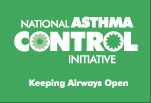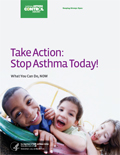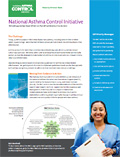Health Care Professionals
Health care providers are the first line of defense when it comes to diagnosing and treating asthma patients.
About one in every 13 people in the United States has asthma, a major cause of illness and disability. Failure to control asthma inflicts a considerable burden on patients, families, and health care systems. For health care professionals who deliver care to individuals with asthma and their families, unplanned acute-care visits for asthma also disrupt practice schedules, and shift patient care out of primary care settings and into emergency rooms and hospital beds.
Clinical trials show that asthma control is within reach for most individuals who have asthma, yet this chronic inflammatory disorder of the airways remains under-recognized and under-treated. The gap between what the scientific literature shows us works and what we do is evident in the fact that less than a third of people with persistent asthma take inhaled corticosteroids to control asthma.
Aim for asthma control.
To help close this gap, the NAEPP’s latest Guidelines for the Diagnosis and Management of Asthma (EPR-3) presents a new focus on monitoring asthma control. Asthma control is the degree to which asthma-related symptoms, functional impairment, and risk of untoward events are minimized and the goals of therapy are met. Simply put, the aim of asthma management is to achieve and maintain asthma control so that people with asthma can stay active and sleep well.
To reinforce the essential aspects of effective asthma management, the EPR-3’s companion Guidelines Implementation Panel (GIP) Report: Partners Putting Guidelines into Action prioritized six clinical practice recommendations that could reduce both the individual and societal burden of asthma if implemented broadly. You can make a difference now by weaving these six GIP strategies into your own practice.
- Use inhaled corticosteroids to control asthma.
- Use written asthma action plans to guide patient self-management.
- Assess asthma severity at the first visit to determine initial treatment.
- Assess and monitor asthma control at each follow-up visit and adjust treatment if needed.
- Schedule follow-up visits at periodic intervals.
- Control exposure to allergens and irritants that worsen the patient’s asthma.
Champion asthma in your profession and community
Whatever your discipline or specialty, you can get involved in the NACI by promoting use of the asthma guidelines to improve asthma control. The links below offer handouts, slides, training materials, and other resources for educating a wide variety of audiences, including patients, caregivers, and professionals. Find highlighted best-practice examples of how to integrate asthma education into your practice, school, or workplace through the NACI Demonstration Projects, NACI Strategic Partnership Program, and NACI Champions Program.
Here are additional ideas for expanding evidence-based asthma best practices:
- Use quality improvement strategies to optimize care delivery and coordination, such as patient-centered teams, point-of-service reminders, spirometry, allergy testing, specialty care, multifaceted home environment and education interventions, and asthma registries.
- Use the Physician Asthma Care Education (PACE) Program for strategies and tools proven to enhance communication with patients and families.
- Partner with patients to write asthma action plans to guide their asthma self-care.
- Select asthma modules to complete maintenance of certification requirements for your professional license.
- Encourage continuing asthma education for members of your health care team.
- Champion the asthma guidelines within your professional networks via credentialing and recertification programs, continuing education courses, presentations, and articles.
Educate patients to succeed
As a health care professional, you can empower your patients, and their families and caregivers, with the knowledge, skills, and confidence they need to control asthma. Rigorous studies show that asthma self-management education is effective in improving asthma outcomes. By increasing inhaled corticosteroid use and other actions that decrease the risk of asthma flare-ups, it also can be cost-effective, especially for patients at high risk for asthma hospitalizations.
Communication makes the difference
How you communicate with patients, families, and caregivers will influence how well they follow the treatment plan. The Physician Asthma Care Education (PACE) Program showed that physicians educated in basic communication strategies to help put guidelines into practice improved patient outcomes and satisfaction without spending more time during visits. PACE also offers coding strategies to maximize reimbursement for patient asthma education.
Moreover, the guidelines note that patients benefit from asthma education programs delivered in a wide range of locations, such as doctors’ offices, community health centers, emergency rooms, hospitals, pharmacies, schools, homes, and community settings. No matter where health professionals interact with patients, the four R’s—reach agreement, rehearse, repeat, reinforce—are the basis for patient self-management education and should occur at all points of care.
 More info:
More info:
- Asthma Action Plan
- Asthma Basics for Schools Slide Set
- Is the Asthma Action Plan Working? A Tool for School Nurse Assessment
- Making a Difference in the Management of Asthma: A Guide for Respiratory Therapists
- Nurses: Partners in Asthma Care
- Physician Asthma Care Education (PACE) Program
- The Role of the Pharmacist in Improving Asthma Care



















 Twitter
Twitter
 Facebook
Facebook YouTube
YouTube